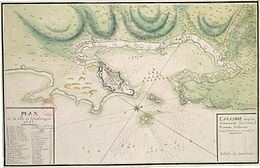Dates 19 Feb 1757 – 25 Jul 1757 | ||
 | ||
Similar Siege of Louisbourg, Petitcodiac River Campaign, Gulf of St Lawrence Campaign, St John River Campaign, Bay of Fundy Campaign | ||
The Louisbourg Expedition (1757) was a failed British attempt to capture the French Fortress of Louisbourg on Île Royale (now known as Cape Breton Island) during the Seven Years' War (known in the United States as the French and Indian War).
Contents
Background
The French and Indian War started in 1754 over territorial disputes between the North American colonies of France and Great Britain in areas that are now western Pennsylvania and upstate New York. The first few years of the war had not gone particularly well for the British. A major expedition by General Edward Braddock in 1755 ended in disaster, and British military leaders were unable to mount any campaigns the following year. In a major setback, a French and Indian army led by General Louis-Joseph de Montcalm captured the garrison and destroyed fortifications in the Battle of Fort Oswego in August 1756. In July 1756 the Earl of Loudoun arrived to take command of the British forces in North America, replacing William Shirley, who had temporarily assumed command after Braddock's death.
British planning
Loudoun's plan for the 1757 campaign was submitted to the government in London in September 1756, and was focused on a single expedition aimed at the heart of New France, the city of Quebec. It called for a purely defensive postures along the frontier with New France, including the contested corridor of the Hudson River and Lake Champlain between Albany, New York and Montreal. Loudoun's plan depended on the expedition's timely arrival at Quebec, so that French troops would not have the opportunity to move against targets on the frontier, and would instead be needed to defend the heartland of the province of Canada along the Saint Lawrence River. However, political turmoil in London over the progress of the Seven Years' War both in North America and in Europe resulted in a change of power, with William Pitt the Elder rising to take control over military matters. Loudoun consequently did not receive any feedback from London on his proposed campaign until March 1757. Before this feedback arrived he developed plans for the expedition to Quebec, and worked with the provincial governors of the Thirteen Colonies to develop plans for a coordinated defence of the frontier, including the allotment of militia quotas to each province.
When William Pitt's instructions finally reached Loudoun in March 1757, they called for the expedition to first target Louisbourg on the Atlantic coast of Île Royale, now known as Cape Breton Island. Loudoun was to command the land forces, while a squadron under Francis Holburne would transport the troops and face any French naval threats.
French preparations
French military leaders had early intelligence that the British were planning an expedition, and also learnt at an early date that Louisbourg would be the target. Between January and April 1757 squadrons sailed from Brest and Toulon, some of which went to reinforce the squadron based at Louisbourg.
Dubois de La Motte commanded a squadron of 9 ships of the line and 2 frigates at Louisbourg, which was joined by that of Joseph de Bauffremont from Saint-Domingue with 5 ships of the line and a frigate, and 4 ships and 2 frigates from Toulon under Joseph-François de Noble Du Revest.
Hurricane
Admiral Holburne was aware of the arrival of French reinforcements, but the expedition was not yet ready, and only sailed in early August. By the middle of the month his ships were patrolling off Louisbourg, but Dubois de La Motte chose to stay in the harbour. As the days progressed, the weather deteriorated.
Finally, on 24 September 1757, the British fleet was scattered by a gale, but the French could not pursue them due to a typhus epidemic. Dubois de La Motte would return to Brest with his sick men on 30 October 1757.
Aftermath
The British succeeded in capturing Louisbourg the following year.
There were significant consequences in the frontier war because of the delays in Loudoun's instructions, and the redirection of the expedition to Louisbourg instead of Quebec. Because Quebec was not targeted, the leaders of New France were able to use forces that would have defended it in operations against Fort William Henry, which Loudoun had left minimally defended in order to man his expedition. In August 1757 General Louis-Joseph de Montcalm led a force of 8,000, including 1,800 Indians, against the British fort. After a short siege the British surrendered. After the surrender, the French-allied Indians harassed and eventually attacked the defenceless retreating British, taking many captives and brutally slaying wounded soldiers. The incident was one of the most controversial events of the war.
